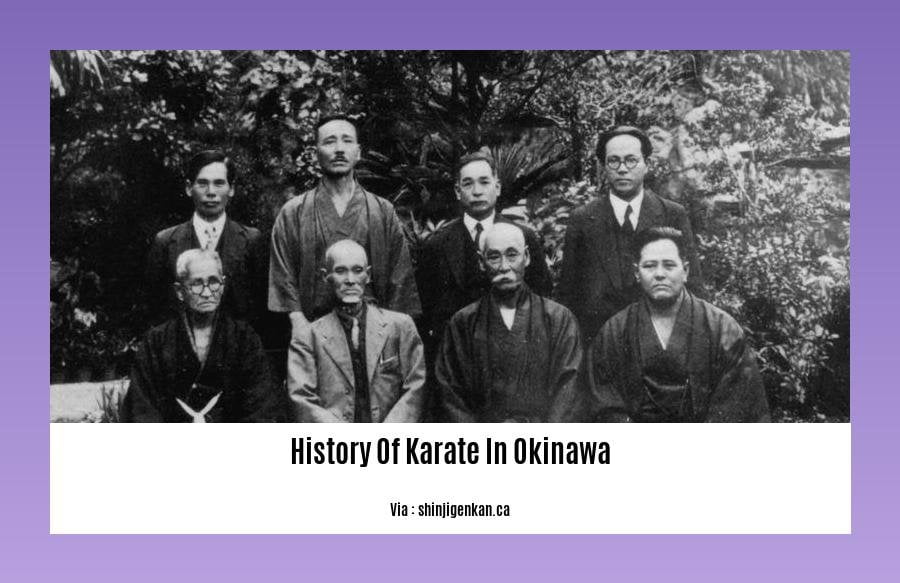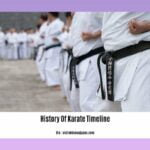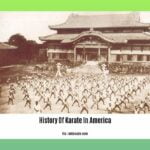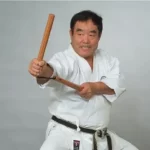Embark on a journey through time as we unveil the rich history of karate in Okinawa. From its humble origins as a self-defense system to its evolution into a globally recognized martial art, this article delves into the captivating tale of karate’s transformation. [Title: Unveiling the History of Karate in Okinawa: From Ancient Roots to Global Recognition]
Key Takeaways:
- Karate originated in East Asia and was systematized in Okinawa in the 17th century.
- The ban on weapons in Okinawa led to the development of unarmed combat techniques that became karate.
- Karate was introduced to Japan in the 1920s.
- Different schools and systems of karate evolved, each with its own variations in techniques and training methods.
History of Karate in Okinawa
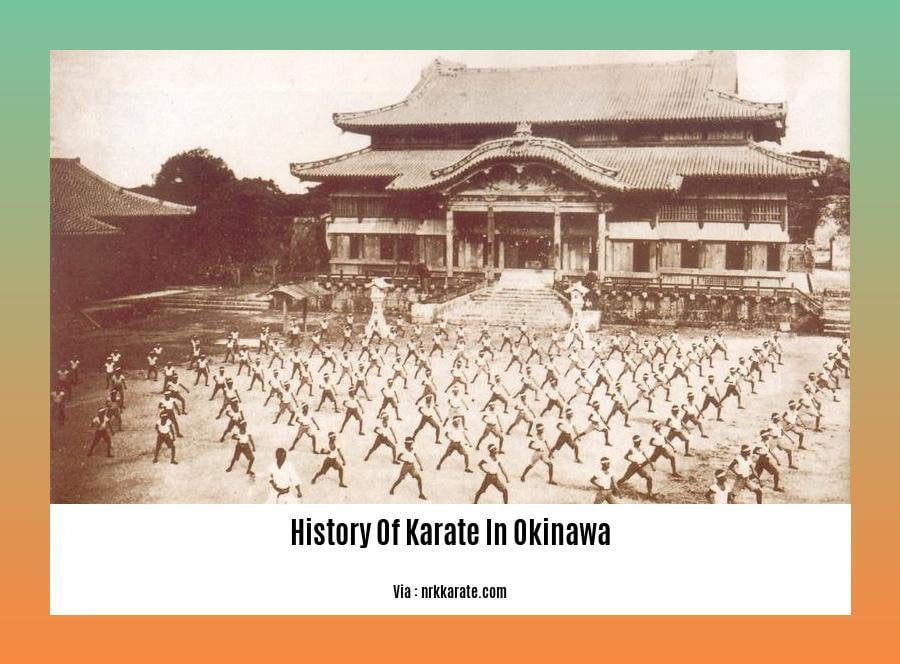
The Genesis of Karate
Our journey through the history of karate in Okinawa commences centuries ago in East Asia. This martial art traces its roots to ancient combat techniques, which were systematically refined and developed in Okinawa during the 17th century.
The Crucible of Okinawa
Okinawa’s unique circumstances played a pivotal role in karate’s evolution. During this era, the island kingdom enforced a strict ban on weapons. This prohibition inadvertently fostered the development of unarmed combat techniques, which gradually evolved into the art of karate.
The Seeds of Karate Sprout
Karate techniques were initially passed down through generations of Okinawan families. These techniques were not formally codified into a single system until the 20th century. Some of the most notable families who contributed to karate’s development include:
- Shuri-te: Originated in Shuri Castle, this style emphasizes circular movements and fast techniques.
- Naha-te: Originating from Naha City, this style incorporates Chinese influences and emphasizes powerful strikes.
- Tomari-te: A blend of Shuri-te and Naha-te, this style is characterized by its balanced approach.
Karate’s Journey to Japan
In the 1920s, karate was introduced to mainland Japan, where it quickly gained popularity. Japanese martial artists helped to systemize and codify karate, leading to the development of various schools and styles.
The Global Expansion of Karate
Following World War II, karate’s popularity surged worldwide. American servicemen stationed in Okinawa were introduced to this martial art and brought it back to the United States, where it quickly spread throughout the country and beyond.
Today, karate has become a global phenomenon, practiced by millions of people worldwide. It has also gained recognition as a competitive sport, with tournaments held at national and international levels.
Ever wondered about the origin of martial arts, and how Karate came to be? Dive into the history of karate to discover its fascinating roots.
Uncover the interesting details that shaped Karate’s evolution by exploring the History Of Karate Facts.
Discover how Karate found its way to the land of the rising sun in the History Of Karate In Japan.
Trace the journey of Karate across the Pacific Ocean and learn about its impact on the West in the History Of Karate In America.
Witness the evolution of Karate over time with the interactive History Of Karate Timeline.
Explore the significance of different colors and their journey in the History Of Karate Belts.
Influence of Chinese Martial Arts (Wushu) on Okinawan Karate
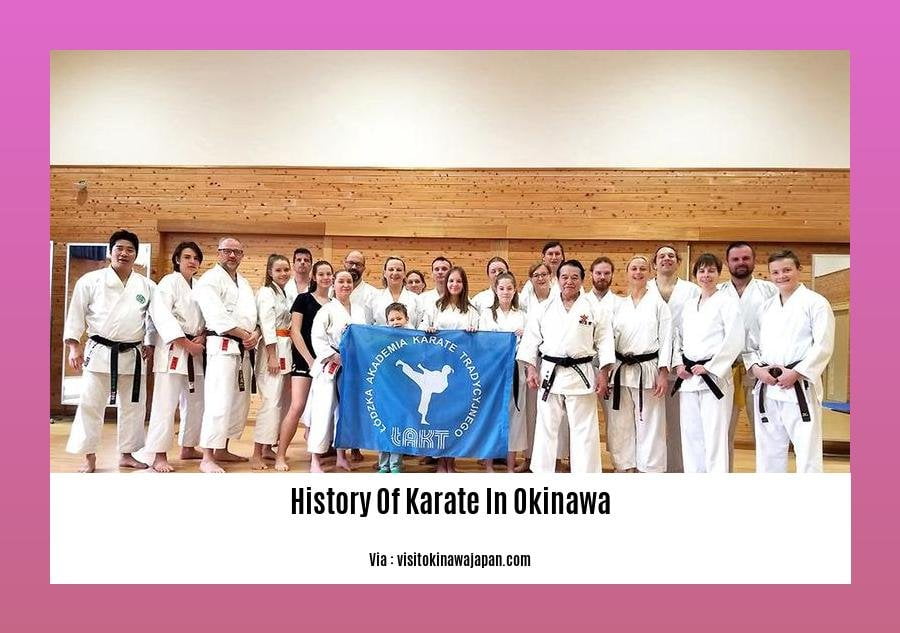
The Ryukyu Kingdom, which later became Okinawa, was once an independent state with close ties to China. As a result, Chinese martial arts, known as wushu, had a profound influence on the development of Okinawan karate.
Chinese Roots
Wushu masters traveled to Okinawa and introduced their fighting techniques, including stances, strikes, and blocks. These teachings blended with existing Okinawan combat methods to form a new fighting style known as “Shorin.”
Evolution of Tō-te
Over time, Okinawans refined and adapted Chinese wushu, combining it with their own combat traditions to create Tō-te (literally, “Tang hand”). Tō-te evolved into various styles, including Shorin, Shurei, and Goju-ryu.
Techniques and Influences
Wushu’s impact is evident in many aspects of karate, including:
- Stances: Karate stances derive from wushu forms, such as the horse stance and the cat stance.
- Strikes: Karate strikes, such as the punch (tsuki) and the kick (geri), draw heavily from wushu techniques.
- Blocks: Karate blocks, such as the inward block (uchi-uke) and the downward block (gedan-barai), have roots in wushu.
Historical Context
The influence of Chinese wushu on Okinawan karate is a testament to the cultural exchange between China and Okinawa. It also highlights the dynamic nature of martial arts, which evolve through cross-fertilization and adaptation.
Key Takeaways:
- Wushu masters introduced their fighting techniques to Okinawa.
- Okinawans blended Chinese wushu with their own combat methods to create Tō-te.
- Tō-te evolved into various karate styles, including Shorin, Shurei, and Goju-ryu.
- Chinese wushu has had a profound influence on karate stances, strikes, and blocks.
- The influence of Chinese martial arts highlights the cultural exchange between China and Okinawa.
Citations:
- Okinawa Karate: Origins and History
- Karate Lineages: How Chinese, Japanese, and Okinawan Martial Arts Intertwined
Karate in the Modern Era: From Secret Fighting System to Global Popularity
The evolution of Karate in the Modern Era: From Secret Fighting System to Global Popularity witnessed a dramatic transformation from a clandestine art to a globally renowned discipline.
Initially, karate emerged as a concealed combat system in Okinawa, veiled from foreign invaders. However, with the introduction of karate to mainland Japan by Gichin Funakoshi, the veil of secrecy was lifted. Funakoshi’s efforts ignited a surge in popularity, transforming karate into a respected martial art and competitive sport.
Post-World War II, American servicemen stationed in Japan embraced karate, carrying its techniques and philosophy back to their home soil. This triggered an explosion of karate schools and practitioners worldwide, solidifying its place as a global phenomenon.
Key Takeaways:
- Okinawa’s Legacy: Karate’s roots lie in Okinawa’s ancient combat techniques, refined and honed over centuries.
- Japanese Influence: Gichin Funakoshi played a pivotal role in introducing karate to mainland Japan, systematizing and codifying its techniques.
- Global Reach: Post-World War II, karate’s popularity soared internationally, thanks to American servicemen who spread its teachings.
- Sport and Self-Defense: Karate evolved into both a competitive sport and a practical self-defense system, appealing to practitioners of all ages and backgrounds.
Relevant URL Sources:
- Smithsonian Magazine: The Centuries-Old Sport of Karate Finally Gets Its Due at the Olympics
- Sports Foundation: Karate History
Preservation and Evolution of Karate in Okinawa Today
Okinawa, the birthplace of karate, continues to be a hub for the preservation and evolution of this ancient martial art. Here’s how Preservation and Evolution of Karate in Okinawa Today:
- Preserving Traditional Techniques:
- Okinawan masters diligently pass down the essence of karate through kata, pre-arranged sequences of movements that embody centuries-old techniques.
Karate schools and dojos in Okinawa strictly adhere to traditional training methods, ensuring the authenticity and effectiveness of the art.
Evolution in Training Methods:
- While traditional techniques remain the core, modern karate practitioners incorporate scientific principles into their training to enhance athleticism, speed, and power.
Technology, such as motion capture and biomechanics analysis, is used to refine techniques and improve performance.
Preservation of Cultural Heritage:
- Karate is deeply embedded in Okinawan culture, both as a form of self-defense and as a symbol of identity.
- The Okinawan government and cultural organizations actively preserve historical sites and artifacts related to karate, fostering a sense of pride and cultural continuity.
Key Takeaways:
- Okinawa remains the epicenter of karate preservation and evolution.
- Traditional techniques are meticulously preserved through kata and strict training methods.
- Modern advancements enhance karate’s athleticism and effectiveness.
- Karate serves as a symbol of Okinawan cultural heritage, fostering a sense of identity and pride.
Relevant URL Sources:
- Okinawa Karate Preserve’s a History of Survival
- The Preservation and Evolution of Karate in Okinawa
FAQ
Q1: What were the key factors that contributed to the development of karate in Okinawa?
Q2: How did Chinese martial arts influence the evolution of Okinawan karate?
Q3: What were the different styles of karate that emerged in Okinawa?
Q4: How was karate introduced to Japan and how did it spread globally?
Q5: What is the significance of Gichin Funakoshi in the history of karate?
- Mastering Leader in Spanish: The Complete Guide - April 19, 2025
- Uncovering Surprising Parallels: England Size Compared to US States - April 19, 2025
- Old Mexico Map: Border Shifts 1821-1857 - April 19, 2025
